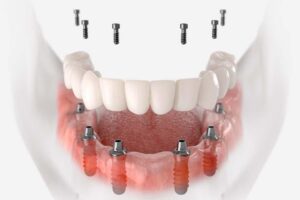
There are many different reasons for teeth to fall out or to become chipped, cracked, rotten or broken. However, whatever the reasons, understandably people can be self-conscious about the gaps in their smiles and so wish to cover them up. This is usually achieved by false teeth, dental implants or dental bridges. A dental bridge is comprised of at least two dental crowns for teeth on both sides of the gap in the jawline – otherwise known as anchoring teeth or abutment teeth – with either the false teeth or tooth in the middle of the crowns. Another name for these false teeth is pontics and can be made from anything from gold, porcelain, alloys or a mixture of all of those materials. The most common material used for dental bridges however is actually porcelain. Patients natural remaining teeth or any other implants will act as supports for the bridges.
The Benefits of Dental Bridges
- Dental bridges, if taken care of properly are almost guaranteed to last a lifetime. They do need to be properly maintained however, if they are to last for any extended length of time. This means time and money can be saved as the patient will not need to constantly go for dental check-ups and or appointments and reapplications. The durability of the dental bridge is one very big advantage as well as a great incentive if a patient is not particularly fond of dental visits and appointments.
- Smile restoration. As mentioned before, people can be very self-conscious about the gaps in their gums and the way it makes their smile look. Dental bridges are a quick and handy solution to this actually very common problem. The false teeth serve to fill in the gaps and restore patients smile to its previous and full potential.
- Free reign of oral movement. Gaps in one’s teeth and gum line can cause some pretty serious and inconvenient speech impediments and also cause pain while eating, speaking or even things as innocuous as yawning. Filling these inconvenient gaps with dental bridges will almost completely fix any problems with excess spittle, drool, problems with pronunciation and speech as well as remove any possible pain that arises while chewing, speaking or yawning. Patients will have free reign of their mouths and complete range of jaw movements once again – without any added fear of embarrassment or pain.
- Face shape. Often with missing teeth, the skin over the jaw and mouth can start to concave or sink inwards towards the gaps. With dental bridges this needs only to be a distant concern of the past as the false teeth, crowns and implants completely fill out the gap caused by missing teeth and therefore restore the face back to its previous shape without any evidence of distortion or without any signs of previous misshapen jaw lines.
- Stronger bite. Naturally, a patient’s bite can be uneven due to gap in their teeth, adding a dental bridge will sort this problem and make the bite more even.




